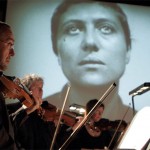I spent the weekend in Annapolis with my folks. By coincidence, I was there while the Annapolis Chorale was staging Richard Einhorn’s Voices of Light, accompanied by a stunning 35 mm print of The Passion of Joan of Arc. Passion live was quite an experience. I would guess that there were about 400 in attendance, which was a pleasant surprise. Nice to see the arts supported so strongly in my old home town.
I think that Einhorn’s score, while beautiful in its own right, is occasionally a bit too much for Dreyer’s film. There are several scenes, particularly near the end, that work better in silence. But, all in all, it was really well done. The four soloists were exceptional — all were visitors, I think, from the Peabody Conservatory in Baltimore — and the Annapolis Chorale was more than up to the challenge. My only gripe was with the first cellist, who muffed a few of his solos.
The 35mm print was better than I had expected. I felt like I was watching the Criterion disc. Seeing it with an audience was really interesting, though. I could feel some resistance at first — particularly from the moron sitting beside me, who tried to entertain his girlfriend by mocking Dreyer’s more stylized images — but for the last twenty minutes, many in the crowd were literally pitched forward in their seats. The best measure of its power, though, was the relative silence of the audience as they filed out of the auditorium. My parents and I were in the car, pulling out of the parking lot, before we said anything.
An hour before the program, the chorale director gave a short lecture on the film and score. Not much new to share, but he did add something to the story of the mysterious print that was discovered in an asylum. Apparently the print was found with a short printed program that included a brief plot synopsis and cast list. They think that one of the doctors in residence may have been a film buff who requested prints for occasional public viewings, a la Bazin’s cine-clubs. If so, I can certainly understand why he would have stored away a copy of Passion for himself.
On Saturday, I delivered my Dumont paper to a small but enthusiastic group at the South Atlantic Modern Language Association conference. The other papers were really interesting. The first used Varda as a test case for the possibility of contemporary auteur studies. It included clips from her first film, La Pointe Courte (1956), which looks fascinating — a transition piece from Neo-Realism to New Wave. The presenter, Richard Neupert from U of Georgia, said that he met Varda recently and reported that she is presently involved in restoring her own films and is very enthusiastic about DVD. Hopefully more of her catalog is on the way.
The other paper was delivered by a Master’s student in the film studies program at Emory, who spoke about American marketing of European filmmakers during the last decade and a half. I wasn’t too interested in her test case, Amelie, but I was surprised to learn that my enthusiasm for foreign films can be attributed, at least in part, to the Weinsteins. She analyzed Miramax’s marketing campaigns for films like Delicatessen and The Cook, The Thief, His Wife, Her Lover, which were the very films that piqued my interest in the late-80s, early-90s. Her conclusion was that, right now, the only foreign films that stand a chance in American markets are those that already conform to American conventions — films that can be pitched as “feel good” instead of “risky” or “provocative,” which remained the model even only ten years ago. We all sat around and chatted afterwards and wondered if DVD has completely changed the distribution channels. Folks like Dumont and the Dardennes find their audiences in homes instead of at the theater.
